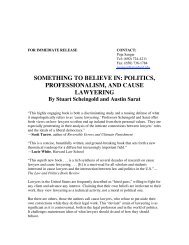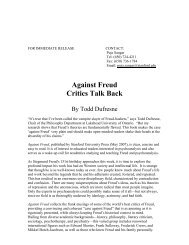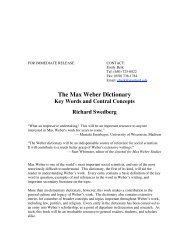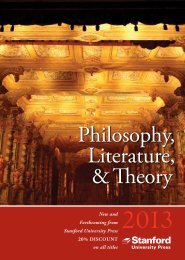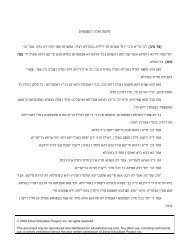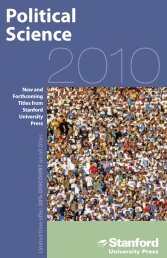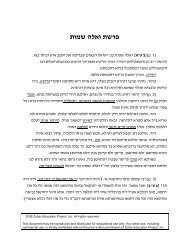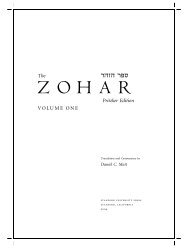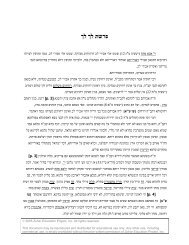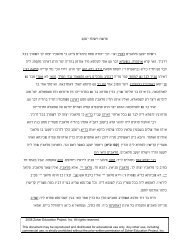Chapter 1 (PDF) - Stanford University Press
Chapter 1 (PDF) - Stanford University Press
Chapter 1 (PDF) - Stanford University Press
You also want an ePaper? Increase the reach of your titles
YUMPU automatically turns print PDFs into web optimized ePapers that Google loves.
are little children, youngsters, as is written: Make two cherubim of gold<br />
These<br />
25:18).'' 25<br />
(Exodus<br />
El'azaropened, ``Lift your eyes<br />
Rabbi<br />
high and see: Who created these?<br />
on<br />
40:26). Lift your eyes on high.<br />
(Isaiah<br />
which site? The site toward which all eyes gaze. Which is that? Opening of<br />
To<br />
eyes. 26 There you will discover that this concealed ancient one, susceptible<br />
the<br />
questioning, created these. Who is that? Who. 27<br />
The one called End of<br />
to<br />
above, 28 whose domain extends overeverything. Since it can be questioned,<br />
Heaven<br />
yet remains concealed and unrevealed, it is called Who. Beyond, there is<br />
Make two cherubim . . . In BT Sukkah<br />
25.<br />
5b, Rabbi Abbahu interprets the word<br />
a child.'' The plump childlike angels<br />
``like<br />
Christian art derive either from this tra-<br />
of<br />
or from the Greco-Roman Erotes,<br />
dition<br />
Here Rabbi Shim'on relates the<br />
``loves.''<br />
cherubim to the golden wreaths of<br />
golden<br />
Song of Songs, concluding that both<br />
the<br />
The phrase originates in Genesis<br />
einayim).<br />
where it means ``the entrance to Ei-<br />
38:14,<br />
a village where Tamar seduced her<br />
nayim,''<br />
Judah. The midrash on Gen-<br />
father-in-law,<br />
(Bereshit Rabbah 85:7) discovers a deepermeaningesis<br />
``Rabbi [Yehudah the Prince]<br />
`We have searched through the entire<br />
said,<br />
and have not found a place called Pe-<br />
Bible<br />
Einayim. WhatisPetaḥ Einayim? Thisindicatetaḥ<br />
that she [Tamar] gazed at the open-<br />
toward which all eyes gaze and said,<br />
ing<br />
it be the divine will that I not leave<br />
`May<br />
house empty.''' In the Zohar, this opening<br />
this<br />
is identified with Shekhinah, gateway to<br />
divine. See 3:71b±72a.<br />
the<br />
Who P K (Mi). Binah, the Divine<br />
27.<br />
is called Who. A spiritual seeker<br />
Mother,<br />
inquire about Her, but such questions<br />
may<br />
not yield ordinary answers. The identity<br />
do<br />
the divine is discovered only in a realm<br />
of<br />
words. The mystical name Who becomes<br />
beyond<br />
a focus of meditation, as question<br />
into quest. See Shim'on Lavi, KP,<br />
turns<br />
``Concerning everything that cannot<br />
1:91a:<br />
grasped, its question constitutes its<br />
be<br />
answer.''<br />
Zohar 1:29b±30a, 45b, 85b±86a, 237b;<br />
See<br />
138a, 139b, 226a, 231b.<br />
2:126b±127a,<br />
End of Heaven above See Deuteronomy<br />
28.<br />
4:32: For ask now of primal days,<br />
were before you: from the day that<br />
which<br />
created humankind on earth, and from<br />
God<br />
end of heaven to the other. InBTḤagigah<br />
one<br />
11b, this verse is interpreted as imposing<br />
limit on cosmological speculation: ``You<br />
a<br />
inquire concerning from one end of hea-<br />
may<br />
to the other, but you may not inquire<br />
ven<br />
what is above, what is below,<br />
concerning<br />
came before, what will come after.''<br />
what<br />
M Ḥagigah 2:1; Bereshit Rabbah 1:10.<br />
See<br />
restrictions on cosmological speculation<br />
These<br />
recall the Gnostic striving after ``the<br />
of who we were, what we have<br />
knowledge<br />
where we were, where we have<br />
become,<br />
thrown, where we hasten, from what<br />
been<br />
are redeemed, what birth is and what<br />
we<br />
(Clement of Alexandria, Excerpts<br />
rebirth''<br />
Theodotus 78:2). See Zohar 1:30a; Moses<br />
from<br />
LeoÂn, Sheqel ha-Qodesh, 31; idem, Sefer<br />
de<br />
20, 375; idem, Sod Eser Sefirot<br />
ha-Rimmon,<br />
Haqdamat Sefer ha-Zohar<br />
[1:1b]<br />
\ (Be-reshit), In the beginning.<br />
K[BZC<br />
no question. 29<br />
C (keruv), ``cherub,'' as M KCZ B<br />
GZM<br />
(ke-ravya),<br />
5<br />
images allude to children.<br />
(Petaḥ<br />
Opening of the eyes V I\ KRKT O<br />
26.<br />
371.<br />
Belimah,<br />
Beyond... The realms beyond Bi-<br />
29.<br />
namely, Ḥokhmah, Keter, and Ein Sof,<br />
nah,<br />
so unknowable that no question con-<br />
are<br />
cerning them can even be formulated.



